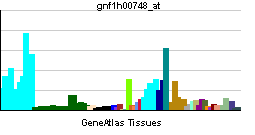CIP29
Jump to navigation
Jump to search
| Cytokine induced protein 29 kDa | |||||||||||||
|---|---|---|---|---|---|---|---|---|---|---|---|---|---|
 PDB rendering based on 2do1. | |||||||||||||
| |||||||||||||
| Identifiers | |||||||||||||
| Symbols | CIP29 ; HCC-1; HCC1; HSPC316; MGC14726 | ||||||||||||
| External IDs | Template:OMIM5 Template:MGI HomoloGene: 41628 | ||||||||||||
| |||||||||||||
| RNA expression pattern | |||||||||||||
 | |||||||||||||
 | |||||||||||||
| More reference expression data | |||||||||||||
| Orthologs | |||||||||||||
| Template:GNF Ortholog box | |||||||||||||
| Species | Human | Mouse | |||||||||||
| Entrez | n/a | n/a | |||||||||||
| Ensembl | n/a | n/a | |||||||||||
| UniProt | n/a | n/a | |||||||||||
| RefSeq (mRNA) | n/a | n/a | |||||||||||
| RefSeq (protein) | n/a | n/a | |||||||||||
| Location (UCSC) | n/a | n/a | |||||||||||
| PubMed search | n/a | n/a | |||||||||||
Cytokine induced protein 29 kDa, also known as CIP29, is a human gene.[1]
References
Further reading
- Maruyama K, Sugano S (1994). "Oligo-capping: a simple method to replace the cap structure of eukaryotic mRNAs with oligoribonucleotides". Gene. 138 (1–2): 171–4. PMID 8125298.
- Suzuki Y, Yoshitomo-Nakagawa K, Maruyama K; et al. (1997). "Construction and characterization of a full length-enriched and a 5'-end-enriched cDNA library". Gene. 200 (1–2): 149–56. PMID 9373149.
- Zhang QH, Ye M, Wu XY; et al. (2001). "Cloning and functional analysis of cDNAs with open reading frames for 300 previously undefined genes expressed in CD34+ hematopoietic stem/progenitor cells". Genome Res. 10 (10): 1546–60. PMID 11042152.
- Choong ML, Tan LK, Lo SL; et al. (2001). "An integrated approach in the discovery and characterization of a novel nuclear protein over-expressed in liver and pancreatic tumors". FEBS Lett. 496 (2–3): 109–16. PMID 11356193.
- Andersen JS, Lyon CE, Fox AH; et al. (2002). "Directed proteomic analysis of the human nucleolus". Curr. Biol. 12 (1): 1–11. PMID 11790298.
- Fukuda S, Wu DW, Stark K, Pelus LM (2002). "Cloning and characterization of a proliferation-associated cytokine-inducible protein, CIP29". Biochem. Biophys. Res. Commun. 292 (3): 593–600. doi:10.1006/bbrc.2002.6680. PMID 11922608.
- Strausberg RL, Feingold EA, Grouse LH; et al. (2003). "Generation and initial analysis of more than 15,000 full-length human and mouse cDNA sequences". Proc. Natl. Acad. Sci. U.S.A. 99 (26): 16899–903. doi:10.1073/pnas.242603899. PMID 12477932.
- Lehner B, Semple JI, Brown SE; et al. (2004). "Analysis of a high-throughput yeast two-hybrid system and its use to predict the function of intracellular proteins encoded within the human MHC class III region". Genomics. 83 (1): 153–67. PMID 14667819.
- Navakauskiene R, Treigyte G, Gineitis A, Magnusson KE (2004). "Identification of apoptotic tyrosine-phosphorylated proteins after etoposide or retinoic acid treatment". Proteomics. 4 (4): 1029–41. doi:10.1002/pmic.200300671. PMID 15048984.
- Hashii Y, Kim JY, Sawada A; et al. (2004). "A novel partner gene CIP29 containing a SAP domain with MLL identified in infantile myelomonocytic leukemia". Leukemia. 18 (9): 1546–8. doi:10.1038/sj.leu.2403450. PMID 15284855.
- Leaw CL, Ren EC, Choong ML (2004). "Hcc-1 is a novel component of the nuclear matrix with growth inhibitory function". Cell. Mol. Life Sci. 61 (17): 2264–73. doi:10.1007/s00018-004-4205-x. PMID 15338056.
- Gerhard DS, Wagner L, Feingold EA; et al. (2004). "The status, quality, and expansion of the NIH full-length cDNA project: the Mammalian Gene Collection (MGC)". Genome Res. 14 (10B): 2121–7. doi:10.1101/gr.2596504. PMID 15489334.
- Andersen JS, Lam YW, Leung AK; et al. (2005). "Nucleolar proteome dynamics". Nature. 433 (7021): 77–83. doi:10.1038/nature03207. PMID 15635413.
- Rual JF, Venkatesan K, Hao T; et al. (2005). "Towards a proteome-scale map of the human protein-protein interaction network". Nature. 437 (7062): 1173–8. doi:10.1038/nature04209. PMID 16189514.
- Sugiura T, Sakurai K, Nagano Y (2007). "Intracellular characterization of DDX39, a novel growth-associated RNA helicase". Exp. Cell Res. 313 (4): 782–90. doi:10.1016/j.yexcr.2006.11.014. PMID 17196963.
| This protein-related article is a stub. You can help Wikipedia by expanding it. |